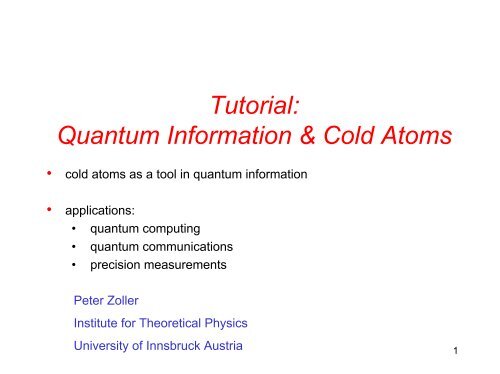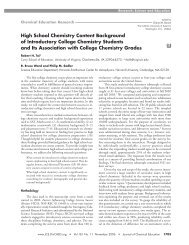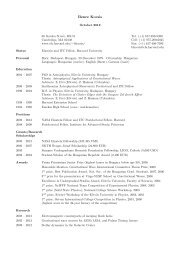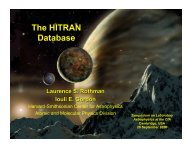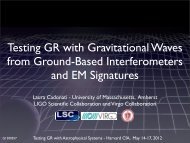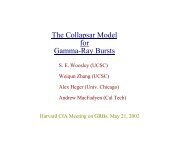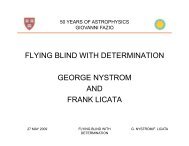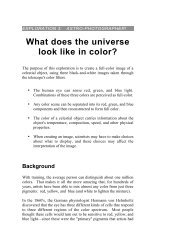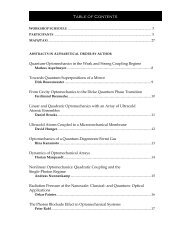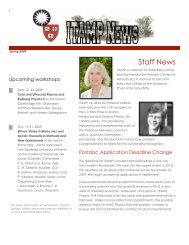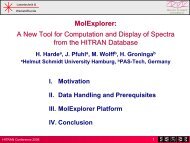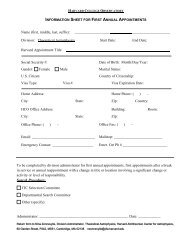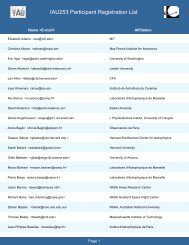Tutorial: Quantum Information & Cold Atoms
Tutorial: Quantum Information & Cold Atoms
Tutorial: Quantum Information & Cold Atoms
Create successful ePaper yourself
Turn your PDF publications into a flip-book with our unique Google optimized e-Paper software.
<strong>Tutorial</strong>:<br />
<strong>Quantum</strong> <strong>Information</strong> & <strong>Cold</strong> <strong>Atoms</strong><br />
• cold atoms as a tool in quantum information<br />
• applications:<br />
• quantum computing<br />
• quantum communications<br />
• precision measurements<br />
Peter Zoller<br />
Institute for Theoretical Physics<br />
University of Innsbruck Austria<br />
1
Entangled States<br />
• entanglement<br />
A B<br />
states:<br />
but also ...<br />
|0 |0<br />
|1 |1<br />
1<br />
2<br />
|0 |0 |1 |1<br />
... product states<br />
... entangled<br />
• fundamental aspects of quantum mechanics<br />
- incompatibility of QM with LHVT<br />
- decoherence<br />
- measurement theory (?)<br />
• applications<br />
- quantum communications & computing<br />
- precision measurement<br />
Schrödinger:<br />
Verschränkung<br />
2
Engineering Entangled States<br />
We need ...<br />
• “quantum engineering”<br />
A B environment<br />
A B<br />
|aA|bB cab|aA|bB<br />
Hamiltonian evolution<br />
• or: “quantum gambling”<br />
measurement<br />
• isolation<br />
|A|B|E |ABE<br />
AB trE|ABE|<br />
|AB|<br />
<strong>Quantum</strong> optical systems provide one of the best set-ups to create<br />
entangled states in a controlled way.<br />
3
<strong>Quantum</strong> Optics Road Map<br />
• Starting from the quantum optical tool box:<br />
photons<br />
... manipulate & couple on level of single quanta<br />
atoms<br />
• we assemble large systems ...<br />
node<br />
channel<br />
• Nodes: local quantum computing<br />
- store quantum information<br />
- local quantum processing<br />
• Channels: quantum communication<br />
- transmit quantum information<br />
4
<strong>Quantum</strong> information processing<br />
• quantum computing<br />
ouput<br />
quantum<br />
processor<br />
input<br />
• quantum communications<br />
|<br />
| |<br />
|<br />
|out<br />
|out Û|in<br />
|in<br />
|<br />
transmission of a quantum state<br />
quantum weirdness:<br />
superposition<br />
entanglement<br />
interference<br />
nonclonability and<br />
uncertainty<br />
no decoherence!<br />
teleportation<br />
crytography<br />
5
Qubits, <strong>Quantum</strong> Gates etc.<br />
• quantum bits or qubits<br />
n spin1/2<br />
• single qubit gate<br />
• two qubit gate<br />
|1i<br />
|0i<br />
example: two qubits<br />
| Û1| U1<br />
control target<br />
| c00|00 c01|01 c10|10 c11|11<br />
|a<br />
|b<br />
|a<br />
Controlled-NOT<br />
|a b<br />
6
1. <strong>Cold</strong> atoms as quantum memory<br />
• technique; cooling and trapping of atoms<br />
• decoherence properties<br />
2. How to entangle atoms?<br />
7
1. <strong>Cold</strong> atoms as quantum memory<br />
• cold atoms • single qubit gates<br />
single trapped atom:<br />
|0 |1<br />
qubit in longlived<br />
internal states<br />
trap<br />
addressing<br />
single qubit<br />
laser<br />
laser<br />
|0 |1<br />
8
Remarks: Traps ...<br />
• ion traps<br />
200 µm<br />
Boulder linear ion trap<br />
NIST Boulder, Innsbruck, Munich,<br />
Hamburg, Aarhus, Oxford, London, ...<br />
ions<br />
issues:<br />
conservative potential<br />
(heating?)<br />
single atom loading<br />
laser cooling to ground<br />
state<br />
9
Remarks: Traps ...<br />
• far-offresonance optical lattice<br />
nonresonant<br />
laser<br />
arrays of microtraps<br />
AC Stark shift<br />
laser<br />
optical lattice<br />
issues:<br />
linear ion trap<br />
conservative potential<br />
single atom loading (?!)<br />
laser cooling<br />
laser<br />
10
Remarks: Traps ...<br />
• loading a lattice from a Bose Einstein condensate<br />
– regular filling with exactly 1, 2 or 3 atoms per lattice site via Mott insulator<br />
quantum phase transition (Bose Hubbard model)<br />
linear ion trap<br />
– large number of atoms<br />
Bose Hubbard model<br />
• superfluid phase<br />
• Mott insulator<br />
theory: Innsbruck 1998<br />
exp: Munich 2001<br />
. . . .<br />
. . . .<br />
<br />
b1 b2 bM |vac<br />
"Fock states"<br />
11
Remarks: Traps ...<br />
• single atom FORTs<br />
array of FORTs (Hannover)<br />
two movable single-atom<br />
FORTs (Orsay)<br />
4 µm<br />
12
Remarks: Traps ...<br />
• magnetic traps<br />
atom "chips"<br />
Schmiedmayer<br />
Heidelberg, Munich,<br />
Harvard, Orsay<br />
issues:<br />
linear ion trap<br />
conservative potential<br />
surface effects (?)<br />
single atom loading (?)<br />
laser cooling (?)<br />
13
... and tricks with traps<br />
• We can move atoms around<br />
|qubit |motion<br />
• optical traps: internal state<br />
dependent potentials<br />
|0 |1<br />
qubit<br />
fine structure<br />
Alkali atom<br />
|0<br />
|1<br />
14
2. Engineering entanglement: two-qubit gates<br />
• implement entanglement of two qubits<br />
U2<br />
• How?<br />
example:<br />
phase gate<br />
auxiliary collective mode as data bus<br />
controllable two body interactions<br />
dynamical phases<br />
geometric phases<br />
|00 |00<br />
|01 |01<br />
|10 |10<br />
|11 e i |11<br />
difficult<br />
15
Concept 1: two-qubit gates via quantum databus<br />
- Entanglement via collective auxiliary quantum degree of freedom<br />
Collective mode<br />
1 2<br />
qubits<br />
quantum<br />
data bus<br />
switch<br />
Examples:<br />
Ion traps<br />
Cavity QED<br />
state vector:<br />
| cx|xN1xN2 x0 |collective mode<br />
x<br />
gate:<br />
quantum register data bus<br />
swap<br />
requirement: cooling of the collective mode (= prepare a pure state)<br />
16
Ion Trap <strong>Quantum</strong> Computer<br />
• <strong>Cold</strong> ions in a linear trap<br />
laser pulses entangle ion pairs<br />
• State vector<br />
Blatt<br />
|Ψi = X cx|xN−1,... ,x0iat om |0iphonon<br />
quantum register databus<br />
theory: Innsbruck, Aarhus, London, Brisbane ...<br />
exp: NIST Boulder, Innsbruck, Munich, Oxford ..<br />
• Qubits: internal atomic states<br />
• <strong>Quantum</strong> gates: entanglement<br />
via exchange of phonons of<br />
quantized center-of-mass mode<br />
• Achievements:<br />
– entanglement of four ions<br />
– Bell measurements<br />
– individual addressing<br />
– ground state laser cooling<br />
17
Optical Cavity QED<br />
• optical photons in a high-Q cavity as "data bus"<br />
laser<br />
spontaneous<br />
emission<br />
cavity decay<br />
theory: Innsbruck, London ...<br />
exp: Caltech, Georgia Tech, Munich<br />
laser<br />
cavity<br />
adiabatic pasage<br />
decoherence free subspace<br />
18
Concept 2: two-qubit gates via two-body interactions<br />
- Controlled two-body interaction<br />
V(R)<br />
1 2<br />
qubits<br />
• physical mechanisms<br />
We must design a Hamiltonian<br />
so that<br />
optical dipole – dipole (Albuquerque)<br />
cold collisions (Innsbruck)<br />
H Et|1 11| |121|<br />
|11 |12 e i |11 |12<br />
Rydberg – Rydberg (Innsbruck + Harvard + Storrs)<br />
19
<strong>Cold</strong> controlled collisions<br />
• consider two atoms in different internal states stored e.g. in an optical<br />
lattice<br />
• we move the lattice in a state dependent way, and induce a collision:<br />
the collision is sufficiently slow not to excite oscillations<br />
before ...<br />
during ...<br />
after collision<br />
atom 1 atom 2<br />
• phase gate via collisions ...<br />
cold atoms<br />
on site interaction =<br />
phase shift<br />
(coherent collision)<br />
20
Entanglement<br />
• parallelism<br />
e<br />
e<br />
• fidelity F~99%<br />
• ... slow <br />
i φ<br />
1 0 1 0<br />
i φ<br />
i φ<br />
e<br />
e i φ i φ<br />
e<br />
1 0 1 0 1 0 1 0 1 0<br />
Lift<br />
Shift<br />
Lower<br />
21
Rydberg – Rydberg interactions<br />
• Rydberg atom in constant electric field<br />
• setup<br />
atom<br />
E<br />
energy<br />
• linear Stark effect<br />
n ~ 15<br />
• Large dipole-dipole interaction<br />
µ 1<br />
Vdipr<br />
µ 2<br />
|r<br />
laser<br />
|g<br />
E<br />
theory: Harvard + Innsbruck +<br />
Storrs, Aarhus<br />
• permanent dipole moment<br />
E 1kV/cm<br />
n 2 huge!<br />
R opt/2 300 nm<br />
E 60 GHz<br />
Vdip 4 GHz<br />
for n 15<br />
22
• 2 qubit quantum gate<br />
|00 |00<br />
|01 |01<br />
|10 |10<br />
|11 e i |11<br />
fast gate<br />
energy shift for time<br />
interval = phase<br />
23
"Dipole blockade"<br />
• atomic configuration<br />
Atom 1 Atom 2<br />
|r1<br />
1<br />
|11<br />
qubit<br />
|01<br />
Vdip u<br />
laser laser<br />
|1 2<br />
qubit<br />
|0 2<br />
2<br />
|r 2<br />
• dipole blockade<br />
2<br />
| r0〉<br />
| 0r〉<br />
1<br />
| rr〉<br />
| 00〉<br />
Vdip u<br />
Large dipole-dipole<br />
interaction shifts level<br />
off resonance:<br />
No double excitation -<br />
no force!<br />
24
3. Mesoscopic atomic ensembles<br />
• idea<br />
– dipole blockade mechanism<br />
theory: Harvard + Innsbruck, exp: Storrs, ...<br />
25
Configuration<br />
• mesoscopic atomic ensembles (instead of microscopic quantum<br />
objects)<br />
- coherent manipulation of collective excitations of atomic ensembles<br />
10 m<br />
-underlying physics:<br />
dipole blockade<br />
N 100 atoms<br />
laser<br />
ground state<br />
|g<br />
|r<br />
laser<br />
|q<br />
26
Manipulating collective excitations<br />
• ground state<br />
|g N |g1|g2 |gN<br />
• one excitation (Fock state)<br />
|g N1 q i |g 1 |qi |g N<br />
• two excitations<br />
|g N2 q i,j |g 1 |qi |q j |gN<br />
laser<br />
etc.<br />
We can store and manipulate qubits.<br />
laser<br />
|g<br />
|r<br />
|q<br />
blockade<br />
27
• actual configuration<br />
hopping via resonant dipole-dipole interaction<br />
atom i atom j<br />
|g<br />
|p<br />
|r<br />
|p<br />
|p<br />
|r<br />
|p<br />
|q |q<br />
|g<br />
resonance condition: Er E p E p Er<br />
idea: Cote, Lukin<br />
28
cont.<br />
• qubits<br />
| |g N |g N1 q<br />
• entanglement of ensembles<br />
+<br />
superposition<br />
29
4. <strong>Quantum</strong> Communication<br />
• Question:<br />
– what can we do with 10 qubit quantum computers?<br />
• Example:<br />
– quantum communication with memory and quantum error<br />
correction = quantum repeater<br />
30
<strong>Quantum</strong> Communications<br />
• classical communications • quantum communications<br />
0 0<br />
Alice Bob Alice Bob<br />
0 0<br />
1<br />
1<br />
0<br />
0<br />
1<br />
|Ψ1i|Ψ2i<br />
networks<br />
cryptopgraphy<br />
|Ψ3i |Ψ4i<br />
|Ψ5i|Ψ6i<br />
Alice Bob Alice Bob<br />
1 0<br />
0<br />
0<br />
1<br />
|Ψ1i|Ψ2i<br />
ρ ρ<br />
Eve Eve<br />
ρ ρ<br />
|Ψ4i<br />
31
Optical Interconnects<br />
• A cavity QED implementation<br />
Optical cavities connected by a quantum channel<br />
Node A Node B<br />
Laser<br />
• memory:<br />
atoms<br />
fiber<br />
• databus:<br />
photons<br />
• memory:<br />
atoms<br />
Laser<br />
32
<strong>Quantum</strong> Communication Protocols<br />
• Problem: the basic problem of quantum communication is noise /<br />
decoherence<br />
Alice Bob<br />
|φi<br />
A<br />
noise<br />
ρ 6= |φihφ|<br />
pure state mixed state:<br />
fidelity F || 1<br />
• Solution: quantum communication in the presence of noise is based on<br />
- teleportation<br />
- purification (error correction)<br />
33
1. Teleportation<br />
Bennett et al. PRL '93; exp with photons: Innsbruck, Rome, Caltech<br />
|φi<br />
C<br />
Alice Bob<br />
A<br />
noise<br />
|AB |0A|1B |1A|0B (singlet)<br />
EPR pair<br />
• Assume: Alice and Bob share a singlet state (given resource)<br />
• Idea: Alice can transmit a qubit to Bob without physically sending the<br />
qubit<br />
B<br />
34
Teleportation protocol:<br />
1. Alice performs a CNOT followed by a measurement of A and C<br />
|φi<br />
C A<br />
CNOT + state measurement<br />
2. Alice tells Bob the measurement outcome<br />
3. Rotation<br />
C<br />
C<br />
A<br />
A<br />
classical communication<br />
The state has been teleported to B.<br />
How do we get the EPR pair?<br />
⎧<br />
⎪⎨<br />
4 possible outcomes =<br />
⎪⎩<br />
∀|φi with prob 1<br />
4<br />
B<br />
|φi<br />
B<br />
00<br />
01<br />
10<br />
11<br />
unitary operation<br />
35
2. Purifying EPR pairs<br />
• A noisy quantum channel allows us to generate many noisy EPR pairs.<br />
1/2 < F < 1<br />
...<br />
Bennett et al., Deutsch et al. PRL '95<br />
purification<br />
F ~ 1<br />
If F 1/2 we can purify and obtain one EPR pair with F 1.<br />
To do this we need a small quantum computer.<br />
• In summary: quantum communication via a noisy channel:<br />
- we generate one high fidelity EPR pair by purification<br />
- we teleport the quantum state<br />
36
3. <strong>Quantum</strong> Repeater<br />
• classical repeater<br />
"1"<br />
"0"<br />
A<br />
classical<br />
signal<br />
L0<br />
C 1<br />
absorption<br />
& dispersion<br />
A B<br />
• quantum repeater:<br />
– we cannot clone a quantum state!?<br />
– Idea: purify segments of EPR pairs ... and teleport<br />
L0<br />
C 2<br />
H. Briegel et al. PRL '98<br />
37
cont.<br />
• <strong>Quantum</strong> repeater protocol: generate a long distance EPR pair<br />
1/2 < F
Other (easier?) implementations<br />
• single atoms, single photons and high-Q cavities: "quantum engineering"<br />
Node A Node B<br />
Laser<br />
• memory:<br />
atoms<br />
fiber<br />
• databus:<br />
photons<br />
• memory:<br />
atoms<br />
Laser<br />
• atomic ensembles, free space, or low-Q cavities: "quantum gambling"<br />
Sample A<br />
Sample B<br />
deterministic<br />
strong coupling on<br />
single quantum level<br />
difficult !<br />
probabilistic<br />
scheme<br />
noise tolerant<br />
linear optics<br />
simpler !<br />
39
To illustrate the ideas ...<br />
Single <strong>Atoms</strong><br />
laser<br />
laser<br />
ion A<br />
ion B<br />
Internal states<br />
ionA ionB<br />
- Weak (short) laser pulse, so that the excitation probability is small.<br />
- If no detection, pump back and start again.<br />
|1i |1i<br />
|0i |0i<br />
- If detection, an entangled state is created.because we do not know<br />
which atom emitted the photon<br />
|0, 1i±|1, 0i<br />
40
Atomic Ensembles<br />
• system: cloud of cold atoms<br />
laser Stokes<br />
ensemble<br />
• Raman process:<br />
|0 N |vac (atomic ground state)<br />
1<br />
Na<br />
Na<br />
<br />
i1<br />
• state of atomic collective mode + Stokes photon<br />
Internal states<br />
laser<br />
|0i<br />
|r<br />
Stokes<br />
|1i<br />
|01 1i 0Na a |vac (single atomic excitation)<br />
| |vac pc a <br />
cStokes|vac O pc<br />
a,a 1 (for weak excitation)<br />
2 pc 1<br />
... analogous to parametric<br />
downconversion<br />
41
Generation of Entanglement (Ensembles)<br />
Sample A<br />
Sample B<br />
|A |B |vacA pc a c s |vacA |vacB pc b c s |vacB<br />
measurement gives<br />
|AB a b |vac<br />
|1a,0b |0a,1b<br />
We have generated entanglement between collective atomic states<br />
42
Continuous Variable Teleportation<br />
• Instead of qubits we consider now continuous variable quantum states<br />
| dx|x x x position<br />
p momentum<br />
x,p i<br />
• transmission of a cv state<br />
|φi |φi |φi<br />
• continuous variable teleportation<br />
|φi<br />
C A<br />
EPR pair<br />
|φi<br />
Alice Bob<br />
|EPRAB dx |xA|xB<br />
dp |pA| pB<br />
|φi<br />
B<br />
Vaidman<br />
Braunstein<br />
Kimble (exp)<br />
x A x B|EPR x 1|EPR<br />
p A p B|EPR p 1|EPR<br />
43
Teleportation with Squeezed Light<br />
• Two-mode squeezed light:<br />
electric field<br />
• Scheme<br />
S. Braunstein, H.J. Kimble et al., PRL '98; Science '99<br />
E ae ikxit<br />
x ip<br />
quadrature components<br />
Bell<br />
3<br />
|φi<br />
out<br />
in 1 2<br />
pump squeezed light<br />
=EPR state<br />
2<br />
parametric<br />
downconversion<br />
EPR source<br />
squeezed light<br />
1<br />
2<br />
44
Atomic ensembles as quantum memory for cont var states<br />
• We consider an ensemble of N atoms<br />
ensemble of<br />
atoms<br />
two-level atom<br />
=spin -1/2<br />
• a collection of two-level atoms can be described in terms of a collective<br />
“angular momentum“<br />
~S a =<br />
collective angular<br />
momentum<br />
NX<br />
µ=1<br />
1<br />
2 ~σ(µ)<br />
two-level atom<br />
= spin -1/2<br />
1 2<br />
Bloch vector<br />
x<br />
z<br />
45<br />
y
atoms cont.<br />
• superposition of the two ground states: coherent spin state<br />
1 2<br />
Bloch vector<br />
• quantum fluctuations<br />
S y a , Sz a iSx a<br />
S y a Sz a 1<br />
2 |S x a |<br />
we treat S x a classically and rescale<br />
X a , P a i X a P a 1<br />
2<br />
canonical communation relations<br />
1<br />
2<br />
|1 |2 N<br />
S a Sx a , Sy a , Sz a N a<br />
2 ,0,0<br />
x<br />
P a<br />
Bloch picture<br />
z<br />
X a<br />
| 46<br />
a dXa |XaX a y<br />
coherent spin state =vacuum state<br />
there are many cv quantum states<br />
around it:
Teleportation with coherent light + atomic ensembles<br />
coherent<br />
light<br />
ex<br />
atoms 1 atoms 2<br />
in<br />
out<br />
measurement projects atomic ensembles<br />
into continuous variable EPR state<br />
|EPR dP|P A| PB dX |XA|XB<br />
theory: Innsbruck<br />
EPR<br />
experiment: E. Polzik et al. (Aarhus), Nature 2001<br />
measure<br />
47
Atomic ensembles: quantum memory for light<br />
• purpose<br />
incoming light pulse<br />
unknown (arbitrary) state<br />
known shape of wave<br />
packet<br />
• how? example ...<br />
theory Harvard, Aarhus<br />
exp: Harvard<br />
write<br />
[ Atomic ensemble ]<br />
storage medium outgoing light pulse<br />
cavity<br />
a1<br />
atoms<br />
read<br />
cavity laser<br />
same state<br />
reshaping<br />
48
4. Precision measurements<br />
• maximally entangled states and squeezed atomic states for precision<br />
measurement beyond the standard quantum limit<br />
theory: NIST Boulder, Innsbruck, Aarhus, Georgia Tech, Harvard<br />
exp: NIST Boulder, Aarhus, Rochester<br />
49
Ramsey method<br />
|0 |1<br />
π /<br />
π /<br />
2<br />
2<br />
#ofatomsin|0<br />
|0 1<br />
2<br />
P0T cos 1<br />
2 L 0T 2<br />
|0 |1<br />
1<br />
2 |0 e i L 0t |1<br />
cos 1<br />
2 L 0t|0 sin 1<br />
2 L 0t<br />
y<br />
<br />
/2<br />
Nb<br />
/2 <br />
0T<br />
x<br />
L 0T<br />
x<br />
x<br />
Bloch picture<br />
z<br />
|0<br />
z<br />
y<br />
y<br />
y<br />
50
We compare ...<br />
• N independent atoms<br />
SQL <br />
1<br />
T nrep<br />
1<br />
N<br />
standard quantum noise limit<br />
Remarks:<br />
N is limited: density / collisions<br />
T is limited: decoherence<br />
• N entangled atoms<br />
ent <br />
• figure of merit: to achieve the same uncertainty ...<br />
2 nrep SQL<br />
nrep ent<br />
N<br />
fN 2 1 N<br />
1<br />
T nrep<br />
• present experiments: NIST Boulder 4 ions entangled<br />
1<br />
fN <br />
1<br />
T nrep<br />
|0000 |1111<br />
1<br />
N<br />
Heisenberg limit:<br />
maximally entangled state<br />
We want 2 1<br />
51
Jx<br />
Example: Spin Squeezing with BEC<br />
• Entanglement via collisions<br />
BEC<br />
|0 N<br />
product<br />
state<br />
Jz<br />
N<br />
laser<br />
• Bloch vector picture<br />
Jy<br />
# atoms N<br />
Jx<br />
[ 1<br />
2<br />
(|0 |1 N<br />
<br />
product<br />
state<br />
Jz<br />
collisions<br />
Jx<br />
Jy<br />
theory: Aarhus + Innsbruck, Georgia Tech,<br />
Harvard; exp.: see also Yale<br />
cn|0 n |1 Nn<br />
entangled state<br />
Jz<br />
squeezing below the<br />
standard quantum limit<br />
Jy<br />
52
5. Topological quantum computing<br />
concept: Kitaev, Preskill, Freedman<br />
• engineering model systems with topologically protected ground states:<br />
indistinguishable under local operations<br />
• Fractional quantum Hall effect: electron in 2D + magnetic field: isolated<br />
ground state with gapped excitations<br />
• on a closed surface of genus g: renders the ground state degenerate.<br />
• transformation of degenerate ground states into each other via motion<br />
of flux quantum around nontrivial topological paths<br />
• Rem.: so far no atomic physics models<br />
53
A (small) first step: ½ - (abelian) anyons in small BECs<br />
• quantum degenerate Bose gas: 2D and rotating trap<br />
BEC<br />
Ω = 0<br />
1 vortex 2 vortices<br />
• what happens is a fractional quantum Hall scenario with bosons<br />
Ω<br />
rotate the trap<br />
?<br />
Ω<br />
Ω ∼ ω<br />
product states entangled states ☺<br />
Laughlin fluid excitations:<br />
½ anyons<br />
laser<br />
we can create and<br />
manipulate anyons!<br />
54
1. System: N bosonic atoms<br />
• N bosons<br />
• Hamiltonian in rotating frame<br />
H = 1<br />
2<br />
NX<br />
µ<br />
−∇ 2 i + r2 i<br />
i=1<br />
Ω<br />
− 2<br />
ω Liz<br />
<br />
+ η<br />
NX<br />
δ(ri − rj)<br />
length scale: motion in trap rotation contact interaction<br />
` =(¯h/mω) 1/2<br />
• In the limit Ω ∼ ω equivalent to (fermionic) quantum Hall Hamiltonian<br />
Gunn & Wilkin '00<br />
Ω<br />
harmonic trapping potential<br />
rotation<br />
Ω<br />
i
2. Energy spectrum<br />
• independent atoms<br />
harmonic trap<br />
...<br />
...<br />
¯hω<br />
2¯hω<br />
Landau wave functions:<br />
z m e − 1 2 |z|2<br />
+ rotation<br />
x + iy<br />
• we assume: dynamics restricted to first Landau levels<br />
Ω<br />
...<br />
...<br />
¯h(ω − Ω)<br />
"Landau levels":<br />
~ degenerate<br />
kT ¿ ¯hω<br />
56
• interacting atoms<br />
– dynamics in first "Landau level"<br />
Vint<br />
collisional interaction<br />
...<br />
¯h(ω − Ω)<br />
rotation<br />
• for Ω ∼ ω a parameter regime of effectively strong interactions<br />
Vint À ¯h(Ω − ω)<br />
external parameter<br />
strongly correlated qu fluid<br />
dilute gas!<br />
57
cont.<br />
• ground state: ½ - Laughlin state<br />
physics: atoms want to be in a collisional dark state to minimize energy:<br />
built from lowest<br />
Landau levels<br />
ψ[z] = Y<br />
i
3. Excitations: ½ anyons<br />
• quasihole at position<br />
ψ z0<br />
z0<br />
[z] =Y(zi<br />
− z0) ψ[z]<br />
i<br />
half atom missing:<br />
½ anyons z0<br />
• creating a quasiparticle: piercing with am offresonant laser<br />
z0<br />
laser<br />
H◦ = HL + V0<br />
X<br />
δ(zi − z0)<br />
i<br />
off-resonant laser interaction<br />
59
4. Anyons & fractional statistics<br />
We adiabatically drag the quasihole around ... and pick up a Berry's phase<br />
• one anyon<br />
• two anyons<br />
ψ z0 −→ eiφ ψ z0<br />
Berry's phase<br />
φ =2πn # atoms inside the curve<br />
ψ z0z1 −→ eiφ ψ z0z1<br />
φ =2π(n −<br />
2<br />
1 )=2πn− π<br />
½ anyons: π/2 bosons:<br />
(fractional statistics)<br />
fermions<br />
π<br />
there is an extra phase<br />
independent of area<br />
if we interchange the two<br />
holes: π/2<br />
2π<br />
π<br />
Fractional statistics has never been seen directly!<br />
60


